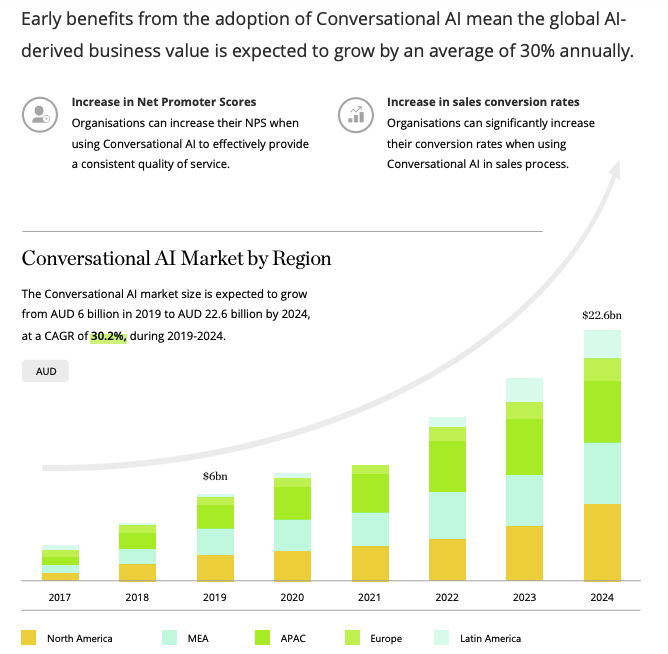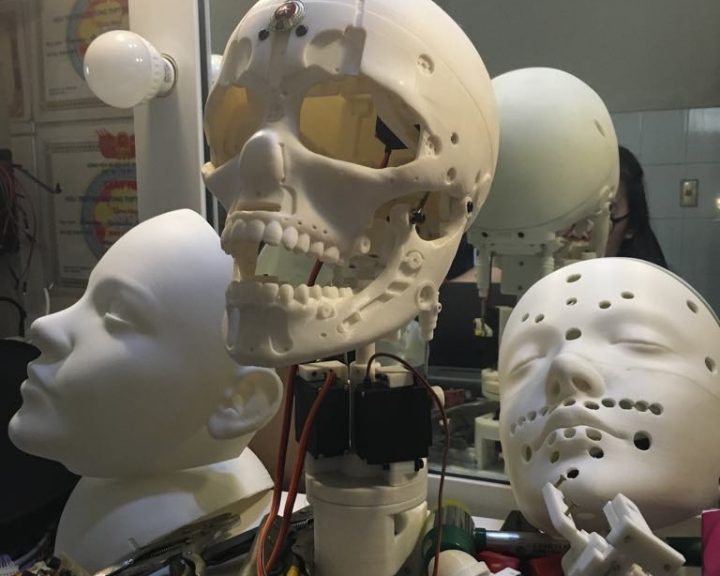
When you hear the words conversational AI, you might reactively scrunch up your face and start to feel alarmed at the concept. AI may seem like a far-off concept that’s as futuristic as it gets. But the reality is, conversational AI is already a part of our everyday lives.
While it’s understandable that you might have your reservations about AI and human-like interactions with computers, the truth is, engineers are working hard to ensure this technology makes our lives at home and at work better, not worse.

So, here, we’ve got a quick “everything you need to know” guide on conversational AI to demystify the concept and to show you how this exciting technology is changing the world.
What is conversational AI?
Conversational AI is artificial intelligence that aims to help humans and computers communicate with one another where the computers can offer human-like interactions.
By recognising speech and text, conversational AI can understand intent, decipher different languages, and respond by mimicking human communication.
The result is an interaction delivered by a computer that’s indecipherable from a human — a rather impressive feat of technology. So, how does it all work?
How does conversational AI work?
In general, conversational AI uses a few different technologies to understand and respond in a human-like manner including:
- Automatic Speech Recognition (ASR) = Listening
- Natural Language Processing (NLP) = Understanding
- Advanced Dialog Management = Responding
- Machine Learning (ML) = Intelligence
Now, each type of conversational AI will use different technologies at different levels. In other words, some are more powerful than others. But, that’s the gist of how it all works.
So, next, let’s go over some of the different types of conversational AI that are out there.
What kinds of conversational AI exist?
There are four main kinds of conversational AI including:
- Purpose-Driven Conversational AI
- Intelligent Conversational AI
- Real-Time Conversaional AI
- Medium-Dependant Conversational AI
Purpose-Driven Conversational AI
At this stage in its development, most conversational AI is purpose-driven, meaning the technology is activated by predetermined questions. In other words, the AI searches for keywords and specific strings of words to come up with an answer for a specific purpose.
Intelligent Conversational AI
Intelligent conversational AI, on the other hand, uses machine learning and is able to, in a way, “think” for itself. This type of AI can retain information, using context and past knowledge to formulate answers.
For example, intelligent conversational AI would be able to have a two-way conversation. So, if you ask, “What’s the weather like in Sydney today?” and then a follow-up question like “What about Melbourne?”, intelligent conversational AI should be able to answer both questions.
Real-Time Conversational AI
Real-time conversational AI is also a two-way street where the AI listens and responds in real-time without any lag. So, instead of a simple digital tool that needs a minute to compute, real-time conversational AI can process and respond more as a human would.
Medium-Dependant Conversational AI
Medium-dependant conversational AI simply means that conversational AI can either be utilised in the form of text or voice activation.
Text-based conversational AI would be something like a chatbot. Voice-based conversational AI is a technology like Apple’s Siri. Both use similar technologies and both can be beneficial since, these days, we’re sending text messages as often as we’re sending voice messages.
What are the challenges of conversational AI?
There are countless challenges to face when talking about conversational AI, both in terms of the technological challenges for engineers as well as the ethical challenges we all face as these technologies are put to market.
The main technological challenges faced by engineers when creating conversational AI include:
- Languages, dialects and accents
- Outdoor settings, excess noise and multiple speakers
- Unscripted questions and answers
- Tone and sarcasm
- Slang and jargon
Whereas some of the main ethical challenges presented by conversational AI include:
- Privacy
- Security
- Discomfort
While many people already use and enjoy using conversational AI in their everyday lives, it’s no secret that many are hesitant to adopt technology that’s potentially indecipherable from a human. We’ve all seen sci-fi films and, to be frank, it makes sense that you might be uncertain.
However, it’s up to the companies that are producing conversational AI technology to ensure they’re clear on their values and protocols to ensure the safety and security of their users. Then, it’s important to educate them about these protocols to encourage more widespread adoption.
What are some examples of conversational AI?
Even if you’re unfamiliar with the term “conversational AI”, it’s possible that you’ve already interacted with this type of technology. Here are some common examples of conversational AI that have already been used for years.
Personal Assistants
Some of the main types of Personal Assistants using conversational AI include Siri by Apple, Alexa by Amazon and Google Home. These technologies and devices are relatively widespread and most people these days have either heard of them or use them regularly.
These personal assistants using conversational AI have countless benefits. Mainly, they can save time and energy as they keep everything from your grocery list to the weather forecast to your daily to-do list organised and automated, activated simply by your voice.
Automated Customer Service
Automated Customer Services is another example of conversational AI that benefits both customers and businesses. Facebook Messenger Bots and FAQ Customer Service chatbots on websites are now a common experience and it’s likely to only continue expanding.
For customers, automated customer service with conversational AI gives you instant answers without waiting on hold listening to outdated elevator music. IBM Watson users achieved a 337% ROI over three years (Source IBM Education 31st August 2020).
For businesses, you can hire fewer customer service representatives and create a more efficient way to answer frequently asked questions or automate basic customer service needs.
All in all, it’s easy to see where conversational AI technology can go.
Final Thoughts
Again, we totally understand where people are coming from when they feel uncomfortable with (or even just completely mystified by) the idea of conversational AI. It’s certainly a revolutionary concept and as engineers, we do need to be careful about its implications.
Still, most of us have already adopted conversational AI in one way or another. And, for most, conversational AI has made both their personal lives and work lives better and more efficient.
How do you feel about conversational AI?








